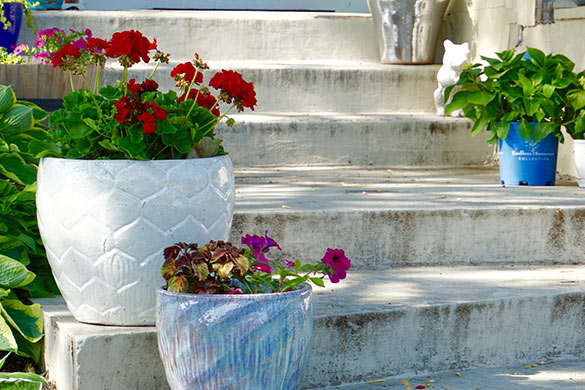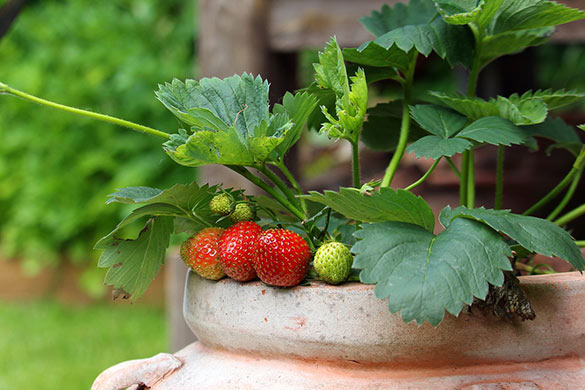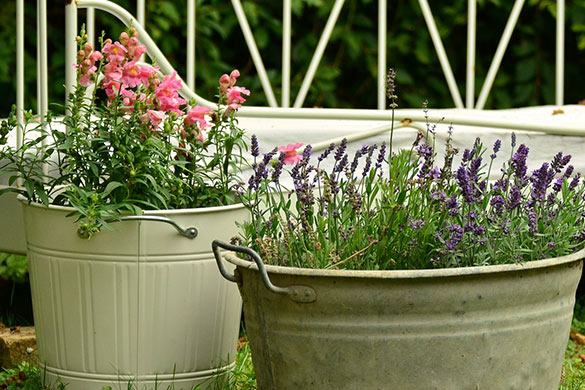Container gardening is versatile, easy to pick up, and the perfect way to keep your green-fingered spirit alive no matter where you are. Essentially, container gardening enables gardening in a small space. It’s likely that you’ve come across a form of container garden before: they could be elaborate hanging baskets at weddings, a tiny cactus on a windowsill or some flowers blooming on a patio during a warm spring evening.
Container gardening is an integral skill for any budding gardener who wants to add some color and ambience to their home without worrying about restrictions like space and placement. If you have ample space in your yard visit homeandgardeningguide.com/gardening-landscaping/ideas/backyard/, otherwise this post will walk you through every aspect of gardening in a small space, looking at factors like container choice, types of compost and the best vegetables for container gardening.
What Makes Container Gardening Different from Normal Gardening?
What makes container gardening so unique and popular amongst both novice and expert gardeners is that it works especially well in small spaces whilst still maintaining a wide breadth of flexibility and functionality with what you can grow. Gardening in a small space offers a range of flexibility – from easy-to-change outdoor displays, to growing your own fruit and vegetables with ease (although you will need to do some research into the best vegetables for container gardening).
It is important to note that container plants need a little more TLC than your average plant order to thrive the same way they would in the ground. Although gardening in a small space might involve a little extra work, it’s by no means impossible – with the right foundations, equipment, tips and tricks, anyone can transform the smallest of spaces to a beautiful hub of nature to admire and harvest.
What Can I Grow with a Container Garden?
The first (and arguably most important) question to ask yourself before you plunge into container gardening is what exactly do you want to plant? Despite the fact that you are gardening in a small space, one of the biggest advantages of container gardening is that there is a lot of versatility in what you can do with it – it’s truly what you make of it!
Questions to Consider when Container Gardening
The possibilities are truly endless, but in these cases, it is important to do your research before diving in and consider the following:
• What time of the year do they need to be planted?
• How much sunlight/water does it need?
• Does it need a specific type of soil/feeder?
• What are the best vegetables for container gardening?
Answering these four essential questions is the first step in ensuring the success of your home-grown produce. However, what is equally as important is ensuring that your care for them is consistent, and being absolutely prepared before diving in no matter how tempting it might be!
Before digging into the best plants for your container, there are more tips and questions about gardening in containers that you may want to consider at extension.uga.edu
Best Vegetables for Container Gardening
A lot of people like to grow their own produce via container gardening – developing fresh herbs and vegetables in a pot conveniently near the kitchen! With the right container (we’ll go into why that’s important later) and conditions, most of the fruit and vegetables you’ll find in widespread allotments can also be produced in a container. Apples, pears and tomatoes are common fruits for container gardening, whilst the best vegetables for container gardening are as follows:
• radishes
• carrots
• peas
• potatoes
• lettuce
• spinach
• peppers and chilis
There are an abundance of vegetables that will thrive in containers, for more options visit missouribotanicalgarden.org
What Else Can You Put in Your Container Garden?
Furthermore, it’s important to note that knowing the answers to the above four questions are equally as fundamental not just for growing produce, but for anything you choose to plant in your container garden. Your options are plentiful, and can range from basil and thyme, decorative leaves and all your favorite flowers like petunias, fuchsias and miniature roses. What makes container gardening so popular in this day and age is that whilst you’re gardening in a small space, you have a large variety of options.
A Thriller, a Spiller and a Filler
You might even want to put a combination of plants into a container, but for a first timer this may be intimidating, and you might not know where to start. When you want to combine plants in a single container, you’ll generally be advised to include ‘a thriller, a spiller and a filler’.
The ‘thriller’, as the name implies, is usually the elaborate focal-point plant that will be the center of your display. This main plant will be complemented and surrounded by small decorative plants and leaves that ‘spill’ over the container. Finally, you have the ‘fillers’ which will be your staple plants all year round – so choose wisely!
These can include further decorative flowers or other ornamental plants like salvias or peppers.
Choosing a Container
But what about containers? It’s important to note that the bigger the container, the bigger the chance that your container garden is a success. It sounds obvious, but roots are the most important part of a plant, and if they are given as much room as possible to grow in a spacious container, everything else will fall into place. This is especially important if you’re planning on putting multiple plants in a single container, or mixing and matching. Make sure that when you pick a container, you are giving your plants room to breathe! Equally, if smaller containers are the only viable option for you, it is best to focus on smaller plants that have smaller roots and, subsequently, require less room.
In any case, it’s always advisable to pick a lighter-colored container if possible. These containers keep the soil cooler whilst darker ones will absorb any heat and dry out the roots, stopping any budding bloom in its tracks.
When picking a container, it is also important to ensure that it has adequate drainage, and if it doesn’t, adapt it so that it does. If the water in a plant has nowhere to drain, the roots can become saturated and begin to rot.
Other Things to Consider When Container Gardening
Location is also a crucial factor, and with this, it is important to let the plant guide you. Whilst some grow best in direct sunlight, others are more likely to thrive if they live in the shade.
Container plants won’t have access to the same amount of moisture they would in the ground, and for that reason it is important to take extra care when it comes to watering and choosing compost. Home-made compost or a multipurpose type from your local garden center will be a lot better than typical garden soil because they are rich in nutrients, lightweight, and retain moisture.
Speaking of moisture, keep in mind that container plants will need more watering than ones in the ground if you want to keep their moisture levels healthy. When watering container plants, you should ensure that the water soaks right through to the plant’s roots, and make sure to do this morning and night – especially if it’s a hot sunny day!
Ultimately, container gardening is a rewarding and flexible skill that anyone can learn – but it can take some time. If your plants end up dying the first or second time you try container gardening, please don’t give up! Keep persevering, researching and planting. Before you know it, your container plants will be in full bloom and you’ll have the garden of your dreams no matter what the size!
Visit http://www.homeandgardeningguide.com/gardening-landscaping/container/ for more container gardening resources, and tips.
The post Container Gardening for Beginners appeared first on http://www.homeandgardeningguide.com



No comments:
Post a Comment